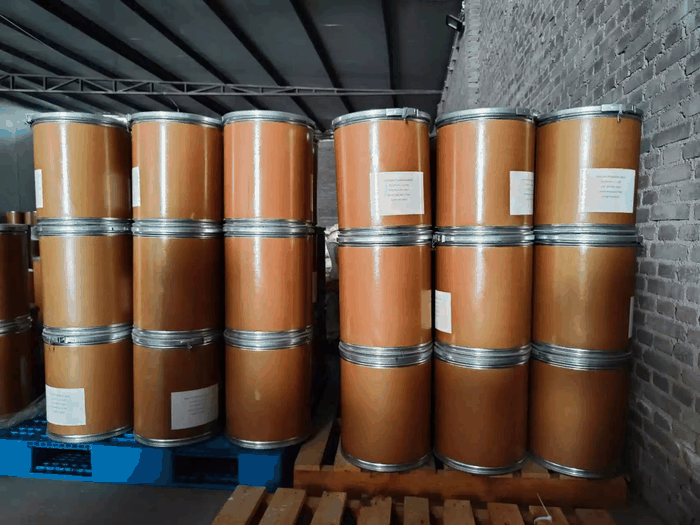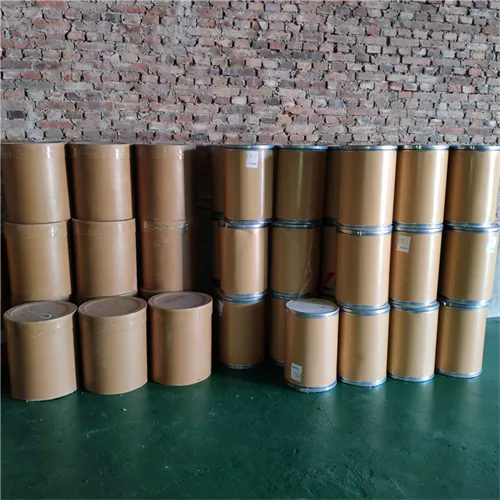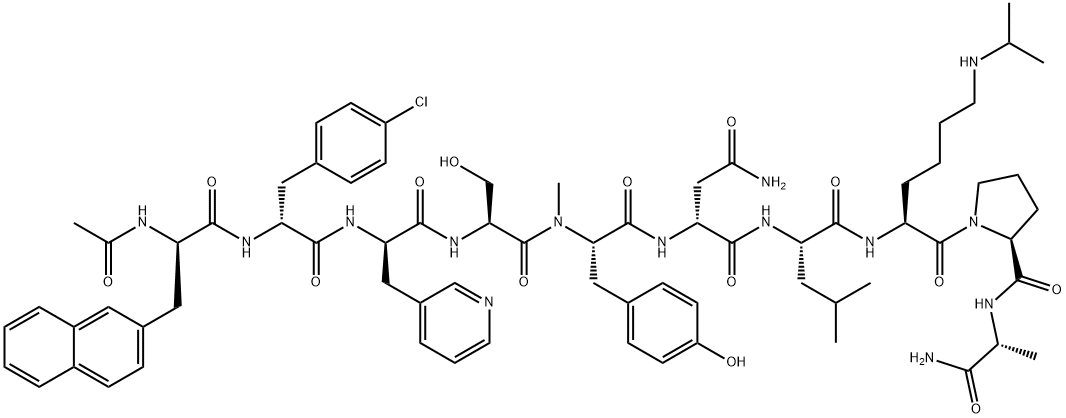Tetracosactide acetate
Synonym(s):α1-24-Corticotropin acetate salt;Tetracosactide;Tetracosactide acetate salt;Tetracosactrin acetate salt
- CAS NO.:16960-16-0
- Empirical Formula: C136H210N40O31S
- Molecular Weight: 2933.44
- MDL number: MFCD00167476
- EINECS: 241-031-1
- SAFETY DATA SHEET (SDS)
- Update Date: 2024-11-29 14:36:51

What is Tetracosactide acetate?
Absorption
Rapidly absorbed following intramuscular administration.
Description
Cosyntropin is a synthetic polypeptide that consists of amino acid residues 1 through 24 of human ACTH, but that has the full biological activity of its parent. Because it is of synthetic origin, it is less allergenic than ACTH of natural origin. Cosyntropin is used as a diagnostic agent in the screening of patients suspected of having adrenocortical insufficiency. Normally, parenteral administration of cosyntropin acts rapidly on the adrenal cortex to effect release of plasma hydrocortisone; when performing the test, the hydrocortisone levels are compared to a control blood sample taken earlier.
Chemical properties
White or yellow, amorphous powder.
The Uses of Tetracosactide acetate
Hormone (adrenocorticotropic).
The Uses of Tetracosactide acetate
Adrenocorticotropic Hormone (1-24), human is used in the treatment of West syndrome. It activates G proteins. It stimulates secretion of glucocorticoid steroid hormones from adrenal cortex cells. It also enhances transcription of mitochondrial genes.
The Uses of Tetracosactide acetate
Adrenocorticotropic Hormone Fragment 1-24 human, rat, has been used in corticosterone enzyme immunoassay and to induce color change in frogs.
Indications
For use as a diagnostic agent in the screening of patients presumed to have adrenocortical insufficiency.
Background
Tetracosactide (also known as Cosyntropin) is a synthetic peptide that is identical to the 24-amino acid segment (sequence: SYSMEHFRWGKPVGKKRRPVKVYP) at the N-terminal of adrenocorticotropic hormone. ACTH (1-24), a segment similar in all species, contains the biological activity that stimulates production of corticosteroids in the adrenal cortex. Tetracosactide exhibits the same activity as natural ACTH with regard to all its biological activities. The complex results in a product whose absorption in man is effected over a longer period of time as compared to corticotropin. Therefore, therapy may be maintained with less frequent administration.
Definition
ChEBI: A synthetic peptide that is identical to the 24-amino acid segment at the N-terminal of adrenocorticotropic hormone (corticotropin). A segment similar in all species, it contains the biological activity that stimulates production of cort costeroids in the adrenal cortex. It is used diagnostically to investigate adrenocortical insufficiency.
Indications
Cosyntropin (Cortrosyn) is a polypeptide that consists solely of the first 24 amino acids of corticotropin. It appears to offer an advantage over the naturally occurring hormone in that it has a longer duration of action and lacks the antigenic portion of corticotropin. Although the short cosyntropin test is recognized as a valid screening test to assess adrenocortical insufficiency, the overnight metyrapone test or insulin hypoglycemia test may prove more sensitive.
brand name
Cortrosyn (Amphastar).
General Description
Cosyntropin (Cortrosyn) is a syntheticpeptide containing the first 24 amino acids of natural corticotropin.Cosyntropin is used as a diagnostic agent to testfor adrenal cortical deficiency. Plasma hydrocortisone concentrationis determined before and 30 minutes after theadministration of 250 g of cosyntropin. Most normal responses result in an approximate doubling of the basalhydrocortisone concentration in 30 to 60 minutes. If the responseis not normal, adrenal insufficiency is indicated.Such adrenal insufficiency could be a result of either adrenalor pituitary malfunction, and further testing is requiredto distinguish between the two. Cosyntropin (250 μg infusedwithin 4–8 hours) or corticotropin (80–120 U/day for3–4 days) is administered. Patients with functional adrenaltissue should respond to this dosage. Patients who respondaccordingly are suspected of hypopituitarism, and the diagnosiscan be confirmed by other tests for pituitary function.Patients who have Addison disease, however, show little orno response.
Biological Activity
Tetracosactide Acetate (SR-TA) stimulates the release of corticosteroids such as cortisol from the adrenal gland. It is absorbed into a zinc phosphate complex, which ensures the sustained release of the active substance from the intramuscular injection site. SR-TA is currently used to manage ulcerative colitis, Crohn's disease, juvenile/adult rheumatoid arthritis, and osteoarthrosis[1].
Biochem/physiol Actions
Activates G proteins.
Pharmacokinetics
Cosyntropin exhibits the full corticosteroidogenic activity of natural ACTH. Various studies have shown that the biologic activity of ACTH resides in the N- terminal portion of the molecule and that the 1-20 amino acid residue is the minimal sequence retaining full activity. Partial or complete loss of activity is noted with progressive shortening of the chain beyond 20 amino acid residue. For example, the decrement from 20 to 19 results in a 70% loss of potency. The pharmacologic profile of Cosyntropin is similar to that of purified natural ACTH. It has been established that 0.25 mg of Cosyntropin will stimulate the adrenal cortex maximally and to the same extent as 25 units of natural ACTH. Cosyntropin has less immunogenic activity than ACTH because the amino acid sequence having most of the antigenic activity of ACTH, i.e., amino acids 25-39, is not present in cosyntropin. The extra-adrenal effects which natural ACTH and Cosyntropin have in common include increased melanotropic activity, increased growth hormone secretion and an adipokinetic effect. These are considered to be without physiological or clinical significance.
Side Effects
Common side effects of Tetracosactide acetate may include: an allergic reaction (hives; difficult breathing; swelling of your face, lips, tongue, or throat); fast or slow heartbeats; increased blood pressure; rash; swelling in your hands or feet.
Veterinary Drugs and Treatments
Cosyntropin is used primarily as an alternative to ACTH to test for adrenocortical insufficiency (Addison’s), or hyperadrenocorticism, particularly in animals who have reacted immunologically to corticotropin in the past or if ACTH gel is unavailable.
Metabolism
Not Available
References
[1] F. Iuliano, M. Rossi, Eleonora Iuliano. “Adding Slow Release Tetracosactide Acetate to Eltrombopag Improves Haematological Response in ITP Patients with Platelet-Count Fluctuation.” Blood (2018).
Properties of Tetracosactide acetate
| Density | 1.47±0.1 g/cm3(Predicted) |
| storage temp. | −20°C |
| solubility | Sparingly soluble in water. |
| form | Solid |
| color | White to off-white |
| Water Solubility | Soluble in water |
| Stability: | Hygroscopic |
| CAS DataBase Reference | 16960-16-0(CAS DataBase Reference) |
Safety information for Tetracosactide acetate
Computed Descriptors for Tetracosactide acetate
| InChIKey | ZOEFCCMDUURGSE-SQKVDDBVSA-N |
Tetracosactide acetate manufacturer
Piramal Pharma Solutions
New Products
Tert-butyl bis(2-chloroethyl)carbamate 4-Methylphenylacetic acid N-Boc-D-alaninol N-BOC-D/L-ALANINOL N-octanoyl benzotriazole 3-Morpholino-1-(4-nitrophenyl)-5,6-dihydropyridin- 2(1H)-one Furan-2,5-Dicarboxylic Acid DIETHYL AMINOMALONATE HYDROCHLORIDE 1,1’-CARBONYLDIIMIDAZOLE R-2-BENZYLOXY PROPIONIC ACID 1,1’-CARBONYLDI (1,2-4 TRIAZOLE) N-METHYL INDAZOLE-3-CARBOXYLIC ACID (2-Hydroxyphenyl)acetonitrile 4-Bromopyrazole 5-BROMO-2CYANO PYRIDINE 5,6-Dimethoxyindanone 5-broMo-2-chloro-N-cyclopentylpyriMidin-4-aMine 2-(Cyanocyclohexyl)acetic acid 4-methoxy-3,5-dinitropyridine 1-(4-(aminomethyl)benzyl)urea hydrochloride 2-aminopropyl benzoate hydrochloride diethyl 2-(2-((tertbutoxycarbonyl)amino) ethyl)malonate tert-butyl 4- (ureidomethyl)benzylcarbamate Ethyl-2-chloro((4-methoxyphenyl)hydrazono)acetateRelated products of tetrahydrofuran
You may like
-
 16960-16-0 Tetracosactide 99%View Details
16960-16-0 Tetracosactide 99%View Details
16960-16-0 -
 16960-16-0 98%View Details
16960-16-0 98%View Details
16960-16-0 -
 Cosyntropin acetate CAS 16960-16-0View Details
Cosyntropin acetate CAS 16960-16-0View Details
16960-16-0 -
 1975-50-4 98%View Details
1975-50-4 98%View Details
1975-50-4 -
 2-HYDROXY BENZYL ALCOHOL 98%View Details
2-HYDROXY BENZYL ALCOHOL 98%View Details
90-01-7 -
 14714-50-2 (2-Hydroxyphenyl)acetonitrile 98+View Details
14714-50-2 (2-Hydroxyphenyl)acetonitrile 98+View Details
14714-50-2 -
 118753-70-1 98+View Details
118753-70-1 98+View Details
118753-70-1 -
 733039-20-8 5-broMo-2-chloro-N-cyclopentylpyriMidin-4-aMine 98+View Details
733039-20-8 5-broMo-2-chloro-N-cyclopentylpyriMidin-4-aMine 98+View Details
733039-20-8







